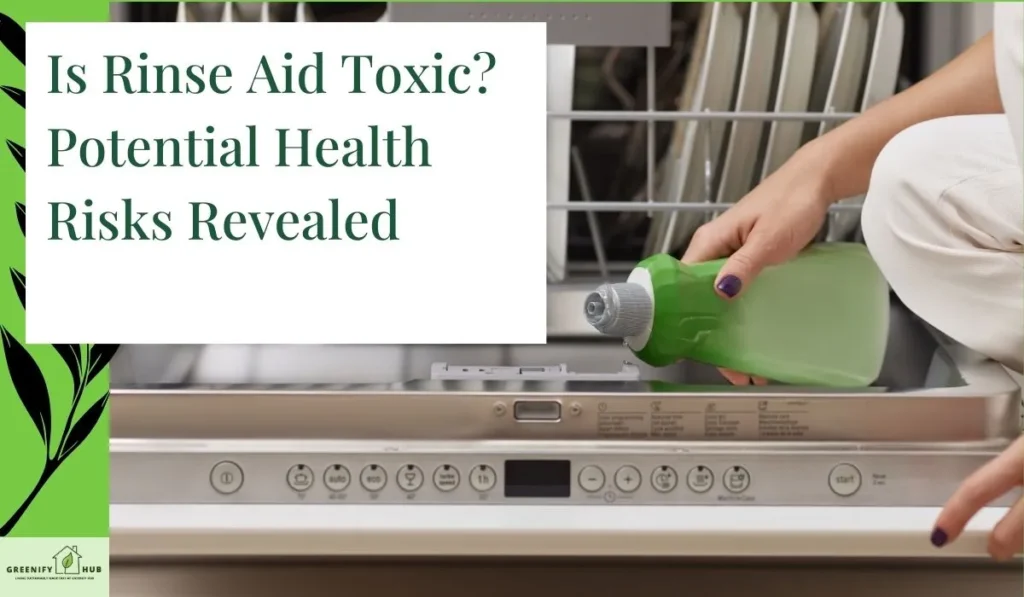Is Rinse Aid Toxic? Potential Health Risks Revealed

Curious about the safety of your household products? Wondering if rinse aid is toxic? While rinse aid enhances drying and reduces water spots, some automatic dishwasher detergents contain chemicals that raise concerns. The contrast lies between convenience and potential health risks.
Rinse aid can improve your dishwashing experience, but understanding its ingredients and their impact is crucial. Stay informed to make safe choices for you and your family. Delve into this article to uncover the truth about rinse aid toxicity.
Key Takeaways
- Be Informed: Understand how rinse aids work and the ingredients they contain to make informed decisions about their use.
- Prioritize Safety: Recognize the health risks associated with certain ingredients in rinse aids and consider safer alternatives.
- Read Labels: Check the ingredients list on rinse aid products and opt for those with fewer harmful chemicals.
- Switch Wisely: Transition to safer alternatives like vinegar or citric acid-based solutions for dishwashing.
- Protect Your Health: Avoid rinse aids containing toxic substances to safeguard your well-being and that of your family.
- Promote Sustainability: By choosing eco-friendly rinse aid options, you contribute to a healthier environment.
Understanding Rinse Aids
Definition
Rinse aids are liquid additives used in household dishwashers to improve the drying process by preventing water spots and enhancing the overall shine of dishes. They work by reducing the surface tension of water, allowing it to drain off quickly.
Rinse aids are different from regular dishwashing detergents as they do not clean the dishes but rather aid in the rinsing and drying stages. Their primary function is to ensure that water droplets slide off dishes easily, preventing streaks and marks.
Importance
The primary purpose of rinse aids is to achieve spotless and streak-free dishes after a wash cycle. By promoting faster drying, they help prevent the formation of water spots on glassware and plastics, leaving dishes looking sparkling clean.
Using rinse aids also helps in maintaining the efficiency of the dishwasher by preventing mineral deposits and limescale buildup. This not only improves the longevity of the appliance but also ensures that dishes come out looking pristine after every wash.
Comparison with Regular Detergents
Unlike regular dishwashing detergents that focus on removing food particles and grease, rinse aids complement the cleaning process by aiding in the final rinsing and drying stages. While detergents clean the dishes, rinse aids ensure that they come out looking shiny and spot-free.
One key difference between rinse aids and detergents is their composition. Rinse aids typically contain surfactants that lower the surface tension of water, allowing it to sheet off dishes easily. On the other hand, detergents contain enzymes and cleaning agents that break down food residues for effective cleaning.
How Rinse Aids Work
Action Mechanism
Rinse aids, such as dishwasher rinse aids, are added during the final rinse cycle in a home dishwasher. They work by reducing the surface tension of water, allowing it to flow off dishes more easily. This helps in preventing water spots and residues from forming on dishes during the drying process.
Preventing Water Spots and Residue
During the final rinse cycle water, rinse aids ensure that water sheets off dishes instead of forming droplets. This sheeting action helps in preventing water spots by ensuring that the water runs off smoothly, leaving dishes spot-free. By breaking down the water’s surface tension, rinse aids enable the water to evaporate quickly without leaving behind any residue.
Improving Drying Process
One of the key benefits of rinse aids is their ability to improve the drying process of dishes. By promoting even water distribution and preventing water from clinging to dishes, rinse aids help in achieving faster and more efficient drying. This results in dishes that are not only clean but also dry and ready to be put away without any additional wiping or handling.
Types of Rinse Aids
Liquid Rinse Aids
Liquid rinse aids are one of the top rinse aids in the market, known for their convenience and effectiveness. They are commonly used in both commercial rinse agents and residential settings. These rinse aids work by reducing water spots and improving drying during the rinse cycle.
Gel Rinse Aids
Gel rinse aids are another popular choice among consumers. They are easy to use and provide excellent drying results. The gel form allows for easy dispensing in rinse agent dispensers in dishwashers. These rinse aids are effective in preventing watermarks on dishes and glassware.
Powder Rinse Aids
Powder rinse aids are a cost-effective option for those looking to enhance the drying process in dishwashers. They are versatile and can be used in various types of dishwashing machines. Powder rinse aids are known for their ability to eliminate residues and improve the overall cleanliness of dishes.
Automatic Dishwasher Rinse Aids
Rinse aids designed for automatic dishwashers are formulated to work efficiently in machine wash cycles. They help in reducing water spots, streaks, and residue buildup on dishes and glassware. These rinse aids are compatible with most dishwashing machines and contribute to faster drying times.
Hand Dishwashing Rinse Aids
For hand dishwashing, specialized rinse aids are available to improve the overall washing experience. These products help in reducing water marks, enhancing shine, and speeding up the drying process when washing dishes manually. They are gentle on hands and suitable for daily use.
Specialized Rinse Aids for Hard Water Areas
In areas with hard water, specialized rinse aids play a crucial role in maintaining the cleanliness of dishes. These rinse aids contain ingredients that effectively combat mineral deposits caused by hard water, ensuring spotless results after each wash cycle.
Rinse Aids for Specific Dishwashing Machines
Certain dishwashing machines require specific rinse aids to optimize their performance. Manufacturers often recommend using compatible rinse aids to ensure proper functioning and longevity of the appliance. These specialized products cater to the unique needs of different types of dishwashers.
Ingredients in Rinse Aids
Common Toxic Ingredients
- Chlorine Bleach: Known to release toxic fumes and can be harmful if ingested or inhaled.
- Phosphates: Contribute to water pollution by promoting algae growth, leading to oxygen depletion in aquatic ecosystems.
- Sodium Hydroxide: Corrosive substance that can cause severe burns on contact with skin or eyes.
Hesitancy of Detergent Companies
- Lack of Regulation: Due to minimal regulations on disclosing rinse aid ingredients, companies often keep their formulas proprietary.
- Trade Secrets: Revealing the complete list of ingredients could expose unique formulations, giving competitors an advantage.
- Avoiding Scrutiny: Some companies may fear public backlash if harmful components are disclosed.
Challenges in Regulation and Monitoring
- Inadequate Oversight: Limited governmental oversight makes it challenging to ensure rinse aids meet safety standards.
- Complex Formulations: The intricate blend of chemicals makes it difficult to monitor and regulate each ingredient’s impact.
- Changing Formulations: Manufacturers frequently alter ingredients, complicating efforts to track potential health and environmental risks.
Health Risks Linked to Ingredients
Adverse Effects
Rinse aids contain chemicals that can pose adverse health effects when ingested or inhaled. Some common ingredients like sodium hydroxide and sulfuric acid are corrosive and can cause burns if they come into contact with the skin or eyes. These chemicals are also harmful if accidentally swallowed, leading to digestive issues and irritation.
Prolonged Exposure
Prolonged exposure to rinse aid ingredients can have serious consequences on human health. Continuous inhalation of chemical fumes while using rinse aids can result in respiratory problems such as asthma, chronic bronchitis, and lung damage. skin irritation and allergic reactions may occur from repeated contact with these harmful substances.
Understanding Health Hazards
It is crucial to recognize the potential health hazards associated with toxic rinse aid ingredients. By being aware of the risks involved, individuals can take necessary precautions to minimize exposure and protect themselves from the harmful effects of these chemicals. Understanding the ingredients present in rinse aids enables consumers to make informed decisions about their usage and prioritize their health and well-being.
Why Avoid Rinse Aids
Environmental Impact
Traditional rinse aids contain toxic chemicals that can have detrimental effects on the environment. When these rinse aids are washed down the drain, they enter water bodies, posing a threat to aquatic life.
The chemicals in toxic rinse aids can accumulate in the ecosystem, leading to long-term damage. Aquatic organisms may suffer from rinse aid exposures, impacting their health and survival.
Water Supply Contamination
Disposing of expensive rinse aids irresponsibly can contaminate the water supply. These chemicals can leach into groundwater sources, affecting both human consumption and agricultural use.
Improper disposal of rinse aid chemicals may result in contamination of drinking water sources, causing serious health concerns for communities. The presence of these substances in water systems can lead to widespread pollution.
Disruption of Ecosystems
The introduction of toxic rinse aids into water bodies can disrupt entire ecosystems. Aquatic plants and animals may be unable to thrive in contaminated environments, leading to a loss of biodiversity.
Moreover, the accumulation of harmful chemicals from rinse aid exposures can have cascading effects on various species within the ecosystem. This disruption can ultimately impact food chains and ecological balance.
Safer Alternatives
Eco-Friendly Options
Switching to eco-friendly alternatives is a great way to avoid the potential toxicity of rinse aids. Look for products labeled as environmentally friendly or biodegradable.
Consider using rinse aid tablets designed specifically for dishwashers. These tablets dissolve during the wash cycle, leaving no residue on your dishes.
Opt for dishwasher pods that are free from harmful chemicals like phosphates and chlorine. These pods are gentle on both your dishes and the environment.
Minimizing Water Spots
To reduce water spots on your dishes, try adding a vinegar solution to the rinse aid compartment of your dishwasher. Vinegar helps prevent mineral buildup and leaves dishes sparkling clean.
Another tip is to ensure your dishwasher’s surfactant levels are balanced. Surfactants help water spread evenly on dishes, minimizing the formation of water spots.
Consider using a water softener if you live in an area with hard water. Hard water can leave behind mineral deposits, leading to unsightly spots on dishes.
Health and Environmental Benefits
Choosing safer rinse aid options not only benefits your health but also helps protect the environment. Traditional rinse aids often contain harsh chemicals that can be harmful if ingested or come into contact with skin.
By opting for eco-friendly alternatives, you are reducing your exposure to potentially toxic substances while still achieving spotless dishes.
Using environmentally friendly rinse aids also has a positive impact on the environment. These products are typically biodegradable, meaning they break down naturally without causing harm to ecosystems.
Pros of Eco-Friendly Rinse Aids:
- Safer for health
- Environmentally sustainable
- Effective in reducing water spots
Cons of Traditional Rinse Aids:
- Toxic ingredients
- Harmful to aquatic life
- May leave residue on dishes
Making the Switch
Transitioning Process
Switching from toxic rinse aids to safer alternatives is a crucial step towards a healthier environment. Start by researching eco-friendly rinse aid brands and reading reviews to find one that suits your needs.
Make sure to thoroughly clean your dishwasher’s rinse aid compartment before adding the new eco-friendly product. This prevents any residual toxic chemicals from mixing with the safer alternative.
Incorporating Eco-Friendly Rinse Aids
When using eco-friendly rinse aids, remember that a little goes a long way. Follow the manufacturer’s instructions on the proper amount to use for each dishwashing cycle.
Consider opting for rinse aids that come in liquid form as they are often more environmentally friendly than their solid counterparts. These liquids are designed to dissolve easily in water, reducing their impact on aquatic life.
Sustainable Dishwashing Habits
To ensure a smooth transition, gradually introduce the new rinse aid into your dishwashing routine. Monitor the results closely to see how it affects the cleanliness of your dishes and the overall performance of your dishwasher.
One of the key benefits of using eco-friendly rinse aids is their minimal impact on both households and the environment. They are formulated to break down safely without causing harm at the end of their cycle.
Closing Thoughts
In understanding rinse aids, you’ve uncovered the hidden risks lurking in your kitchen. By learning how these products work and the concerning ingredients they contain, you now hold the power to make safer choices for you and your loved ones. Choosing to avoid toxic rinse aids and opting for natural alternatives not only safeguards your health but also contributes to a safer environment.
Take charge of your well-being by making informed decisions. Swap out harmful rinse aids for eco-friendly options, protecting both your family and the planet. Your small changes can lead to significant impacts, creating a healthier home and a better world for all. Stay informed, stay safe, and make the switch today.





